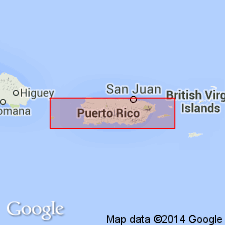
- Usage in publication:
-
- Guanajibo formation
- Modifications:
-
- Named
- Dominant lithology:
-
- Limestone
- AAPG geologic province:
-
- Caribbean region
Summary:
Named Guanajibo formation for Guanajibo Channel, PR. Consists of a series of light-yellow to gray limestones, sandy or earthy and ranging from soft to fairly hard and sands, silts, and clays. Deepest well to end in these sediments is well Mg36 at 256 feet. Unit is of late Miocene or early(?) Pliocene.
Source: GNU records (USGS DDS-6; Reston GNULEX).

- Usage in publication:
-
- Guanajibo Formation*
- Modifications:
-
- Overview
- AAPG geologic province:
-
- Caribbean region
Summary:
The Guanajibo Formation occurs in southwest Puerto Rico and consists of calcarenite and calcirudite with local interbeds of lithic sandstone and conglomerate. Estimated thickness is 30 meters. The Guanajibo is of late Miocene age.
Source: GNU records (USGS DDS-6; Reston GNULEX).
For more information, please contact Nancy Stamm, Geologic Names Committee Secretary.
Asterisk (*) indicates published by U.S. Geological Survey authors.
"No current usage" (†) implies that a name has been abandoned or has fallen into disuse. Former usage and, if known, replacement name given in parentheses ( ).
Slash (/) indicates name conflicts with nomenclatural guidelines (CSN, 1933; ACSN, 1961, 1970; NACSN, 1983, 2005, 2021). May be explained within brackets ([ ]).

